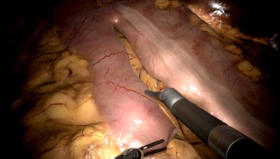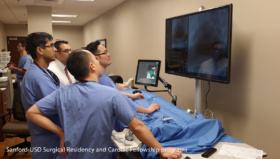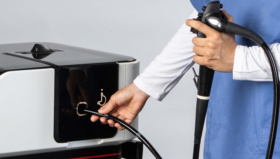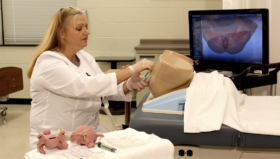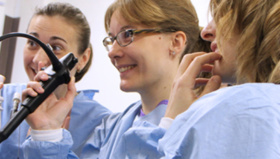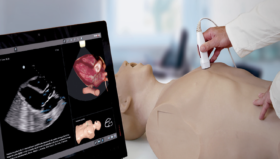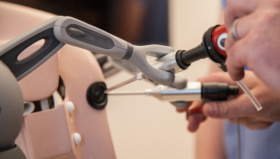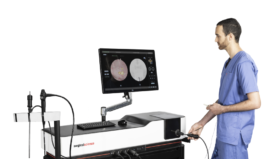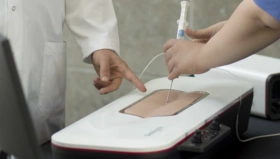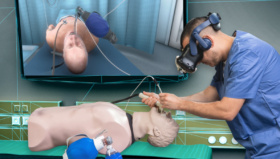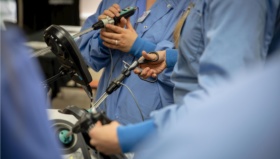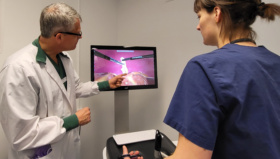Practicing on a Simulator, Not Patients
Founded in 2002, The Dr. Robert and Dorothy Rector Clinical Skills and Simulation Center (CSSC) at Thomas Jefferson University in Philadelphia, Pennsylvania has set as its mission “to be an international leader in the development, implementation, and evaluation of curricula that use simulation in teaching and assessing the core clinical skills sets required to be a physician, nurse of health care professional and by so doing, inspire others to teach using these tools.”
The Challenge
When Dr. Costas D. Lallas, Professor of Urology and Vice Chair of Academic Affairs at Thomas Jefferson University and Dr. Daniel P. Verges, fellow of Endourology and Minimal Invasive Urologic Oncology reviewed the survey on Urology Residency programs in the US, they found that 85% have some form of simulation lab available for trainees.
However, only 50% have virtual reality simulators; the other 50% are using physical training consoles that are connected to the physical console in the operating room and some of these programs require an attending physician present to be present during the simulation. Of these 50%, only 18% had validated curricula for robotic surgery.
Dr. Lallas explained that when we were looking for a simulator for robotic surgery, we wanted a simulator to replicate both the hardware and the software of the robotic console used in the operating room but without being connected to the actual physical console in the operating room. We wanted a system that was available 24/7 to the all trainees – medical students, residents, fellows, and even attending physicians. Equally important was to have a metrics system to assess the proficiency of the trainee and to use for measuring improvement.
The Solution
The Rector CSSC recently purchased Surgical Science’ RobotiX Mentor simulator for hands-on practice of basics skills and procedures. RobotiX Mentor and LAP Mentor programs are used for the acquisition of both basic and advanced minimally invasive and robotic surgical technique. A curriculum was designed which specifies a series of RobotiX and LAP Mentor modules, and which must be successfully completed prior to participating in in vivo urologic robotic surgery. By extension, this curriculum must be completed prior to graduation and residents are free to determine the timing of this completion.
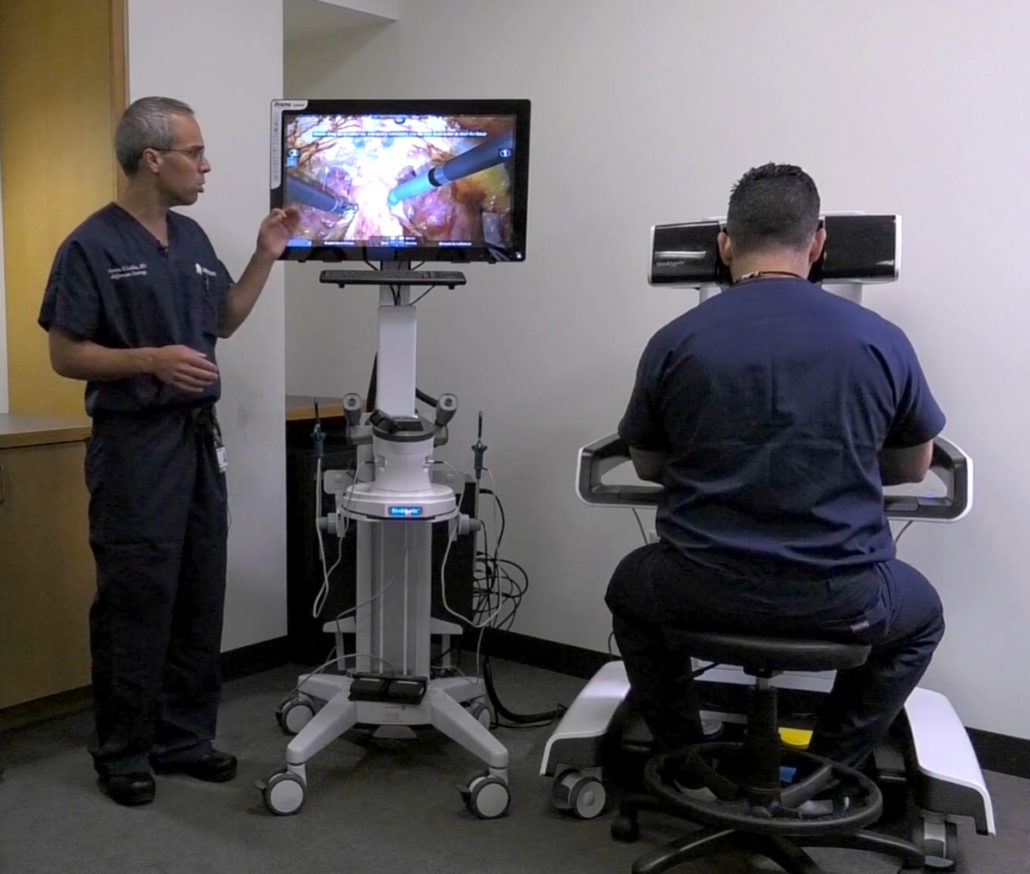
“While a picture is worth a thousand words, an accurate, virtual-reality, surgical simulation module is worth a thousand hours in the operating room.”
Advantages
According to Dr. Lallas, the RobotiX Mentor simulator was exactly what they were looking for. He enumerated its principle benefits and advantages for their robotic simulation program as:
Realistic Hardware – We were looking for a simulator that would be like the Da Vinci console we have in our operating rooms. The RobotiX Mentor is very similar to what you see in the OR – extremely realistic console, adjustable height, pedals just like what you see on the console in the OR, free-moving joysticks that replicate what we have in the OR, and 3D visualization.
Standalone Unit – “What I like is that it is a separate device. Some of the other simulation systems have to be connected to the actual robot. So, you can’t really use these during the day.”
Dr. Verges added,”The drawback of simulation centers using trainers connected to the console in the operating room is that if cases are scheduled, which there often are, the trainee can’t use the simulator.
Additionally, for training programs that require attendings to be present when using those simulators, most attendings don’t have time to do this. The RobotiX Mentor allows us to come in 24/7 on our own time to be able to use these simulation modules.”
Both Skill Sets and Procedural Modules – When we looked at most of the simulators on the market, they were very good for novices but when you become a little more experienced, there wasn’t much application for these virtual reality simulators.
“Surgical Science has boosted that experience with procedural modules, so that now more experienced robotics surgeons can come in and actually practice operations as opposed to just practicing skills. They are getting a lot of benefit from that.” Dr. Verges added: “There are many parts of operations that are very stress-inducing for the attendings as well as for the trainees. What that means is that you might not get to do this in the operating room until the end of your training if at all. The nice thing about Robotix Mentor is that it lets us do these portions of a procedure multiple times in a fairly comfortable environment and practice these very difficult parts of the operations.”
Realistic Simulation – “One thing that I was sold on is the extremely realistic tissue dynamics; it is exactly like what you see in the operating room – how the tissue behaves to dissection and energy, the anatomy, and even the sutures,” said Dr. Lallas.
It not only teaches you the anatomy, but by virtual cues, teaches how to tell how much pressure to apply without causing trauma to the patient.
Team Training – We use the LAP Mentor simulator to allow the robotic assistant to develop the basic and advanced laparoscopic skills to be a good assistant. Together with the RobotiX Mentor, you can see how the assistant’s movements help or hinder the robotic surgeon. This is important to developing a good working relationship between the two.
Guided Procedures and Free-Hand Training – Another thing that we really liked about the Surgical Science robotic simulation is the on-screen guidance that was easy to understand, included instructions and colorful cues of how to perform the procedural steps as well whether they are done correctly.
Once the trainees feel comfortable with the Guidance part of the simulation, they can go a step further with the free-hand procedure with no guidance prompting. Dr. Lallas explains:
These procedural modules not only walk you through the operation but have the option for free-hand as well. This has huge implications for trainees who are learning the operation.
Metrics in Performance Reports – What I like about the Surgical Science performance reports,” explains Dr. Lallas, “is that we can tailor them to what we think is important. What we wanted to do as part of our curriculum here at Jefferson is to set proficiency levels for those metrics so that when my trainees come in, I expect them to get to these levels in order to proceed to the next step in the operation which in some instances will be going to the actual operating room.”
In reviewing the performance reports, I can see the trainees’ accuracy in the entire operation but also their errors. I can review these errors with the trainees because this is something they need to focus on. I can also judge how the trainees have done over time to see if they have achieved to the proficiency level that I expect.”
The Outcome
While a picture is worth a thousand words, an accurate, virtual-reality, surgical simulation module is worth a thousand hours in the operating room
said Dr. Verges. Just as the Federal Aviation Administration outlines minimum experience requirements for multiengine airplane rating (including both cockpit and simulator hours), surgical societies may begin to require such proof of experience and certification.
Dr. Lallas concludes, “The RobotiX Mentor system allows for convenient acquisition of virtual reality surgical simulation hours in a comfortable, convenient, and non-sterile environment. It allows us to practice both basic and advanced robotic surgical skills in a setting outside of the operating suite. This provides convenience to both attending and resident surgeons alike.”
